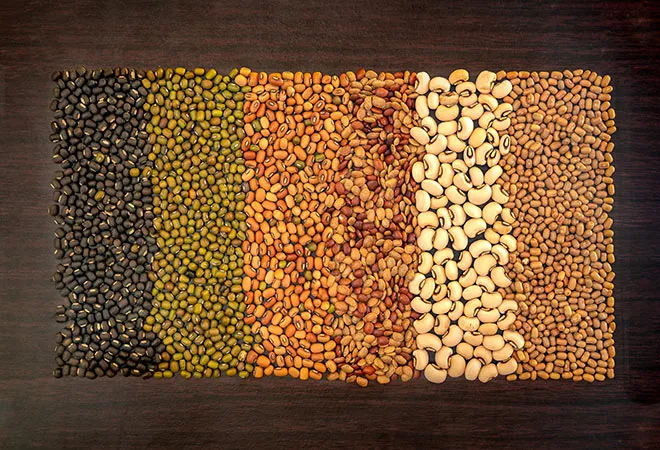-
CENTRES
Progammes & Centres
Location

Image Source: Getty
The celebration of World Pulses Day’ is an opportunity to heighten public awareness of the nutritional benefits of pulses and their contribution to sustainable food systems and a #ZeroHunger world. Pulses have intrinsic value being packed with nutrients, high protein content, low fat and high fiber, which keeps cholesterol and blood sugar under control. Not only do they improve food security and create economic stability, but they also contribute to climate change mitigation by reducing greenhouse gases.
According to the UN Food and Agriculture Organisation (FAO) Director-General, ‘pulses’ play a crucial role in addressing food insecurity and achieving healthy and balanced diets for all, pointing to the need to unlock their full potential to accelerate progress towards the Sustainable Development Goals (SDGs) of the 2030 Agenda. This year’s theme for World Pulse Day is “Nutritious Seeds for a Sustainable Future”, which explains in itself the value of pulses.
Despite the global progress that has been achieved in advancing food security and alleviating poverty, the number of hungry people in the world continues to grow, reductions in child stunting remain insufficient, and obesity is on the rise. With more than 840 million people estimated to be undernourished by 2030, the world is not on track to achieve ‘Zero Hunger’. The pandemic has further threatened lives and livelihood by reversing decades of progress on ending hunger and achieving food security. A UN World Food Programme (WFP) report indicates a rise in hunger due to the pandemic, with an approximately 270 million people facing food insecurity as opposed to the 149 million during pre-COVID times. This is a matter of grave concern.
India ranks 94 out of 107 countries on the Global Hunger Index 2020. It falls under the category of ‘serious’ level of hunger. The Lancet attributed two-thirds of the 1.04 million deaths in children under the age of five in India to malnutrition. Of the 144 million stunted under-five children in the world, India alone accounts for 46.6 million. Furthermore, India is home to 25.5 million off the 47 million wasted under-five children globally. The COVID-19 pandemic will possibly take the toll up by ten to twenty percent, worsening India’s malnutrition problem.
Research indicates a direct correlation between dietary diversity—with the quality of diet and household food security—and higher socio-economic status in terms of maternal education and employment. According to the NFHS-4 2015-16, only 9.6 percent children (6-23 months) are fed a minimum acceptable diet. Going by the latest NFHS-5 for 22 states/UTs, there is a slight improvement in percentage of children receiving an adequate diet, ranging from 5.9 percent in Gujarat to 29.8 percent in Meghalaya. According to the Eat-Lancet Commission on Food, Planet, Health, India needs to enhance dietary diversity and behaviour change as it is crucial to achieving nutrition security. Pulses can contribute to the overarching issue of food security in a number of ways, as elicited in figure.
 Source: Food & Agricultural Organization of United Nations
Source: Food & Agricultural Organization of United Nations
FAO suggests ‘Overcoming hunger and malnutrition in the 21st century means increasing food quantity and quality, while making sure we produce food sustainably, efficiently and safely’. In India only 42 percent children (6-23 months) have minimum meal frequency (fed the minimum number of times per day for their age),and a mere 21 percent have minimum dietary diversity (diet containing four or more food groups—Grains, Pulses and Legumes, Milk and Milk products, Eggs, Fruits and Vegetables, and Fresh Foods).
As per the household expenditure survey report, there has been a declining trend in the spending and consumption of protective foods like pulses and milk. India derives its protein from cereal-based diets and improving the quality, specifically that of protein through pulses, is necessary to tackle malnutrition. Despite India being the world leader in pulse production at 20 million tonnes (25 percent of global production), a high demand-supply gap exists for pulses in India.
A Study on different diets across Indian states and income groups has found consumption patterns to be unhealthy, without the required proportion of proteins, fruits and vegetables. A seven city survey across India found 73 percent of the respondents to be protein deficient with 93 percent of them unaware of their daily protein requirements. The 68th round of NSSO indicates that currently, cereals constitute the major source of protein to Indians, despite the fact that pulses are the cheapest source of protein. Pulses contribute 10 percent of dietary protein, with a modest increase in monthly per capita consumption. Supplementing cereal-based diets with pulses can potentially bring down malnutrition. Evidence suggests that individuals with more frequent consumption of pulses are more nutritionally secure.
Pulses are an indispensable source of protein in Indian diets. The Government of India’s food security programmes provide for 50 percent of the recommended dietary allowance of protein to children, adolescent girls, and pregnant and lactating women. The government announced a relief package during the pandemic, providing for an additional supply of 5 kg rice/wheat and 1 kg of preferred pulses per month. Some states namely Andhra Pradesh, Telangana, Haryana, and Himachal Pradesh have succeeded in providing pulses through the Public Distribution System (PDS).
As a policy, the PDS should provide pulses at subsidised rates to make them more affordable and available. This will provide the much needed nutritional security, especially to the vulnerable section of our population. There is an urgent need to create awareness on the consumption of macronutrient rich pulses for the dual benefit of nutrition and sustainability. For a healthier future generation, act now!
The views expressed above belong to the author(s). ORF research and analyses now available on Telegram! Click here to access our curated content — blogs, longforms and interviews.

Dr. Shoba Suri is a Senior Fellow with ORFs Health Initiative. Shoba is a nutritionist with experience in community and clinical research. She has worked on nutrition, ...
Read More +